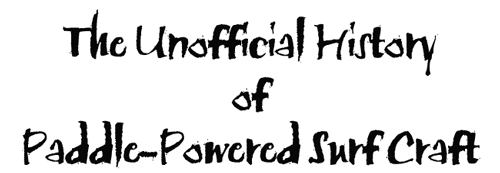
The ocean surf is as eternal as the four seasons, seemingly endless in the history of human existence. As first man gazed upon the beauty of the breaking waves, I am sure he witnessed the ocean mammals frolicking in the surf. These playful creatures and the food they represented, enticed early man to develop a means of entering the surf environment. Whether in reed boats, sealskin kayaks, or redwood canoes, man did enter the surf zone. While I am convinced we will never identify the first person to ever surf a wave in a paddle craft, I am confident many people were autonomous in their discovery. This should negate any attempt (by a living human) to lay claim to being the "first." In an attempt to retrace the recent history of paddle-powered surf craft, I have contacted a unique few of the modern innovators to supply me with their memories.
Malcolm Pearcey (designer of the world-renowned "Jester" surf kayak) recalls the early days of surf kayaking in Europe. "People used to take their race boats out in the surf in the early sixties, and this led to organized competitions by the end of the decade. A complex system of regional contests determined the national teams. These team members would then compete for the 'Home International' team and individual titles." The Home International consists of teams from Scotland, Ireland, Wales, and England. These early competitions evolved to become the foundation for our current organization of the World Kayak Surfing Championship. Malcolm continued, "The seventies showed a major boom in the sport with the peak occurring around 1976. The decline of kayak surfing (in Europe) was brought about by the increase of wave skiing. With the two factions going separate directions, most 'paddle surfers' chose the less limiting and more radical appeal of wave skiing. Since the late eighties, kayak surfing has been on the rebound, mainly due to the introduction of better designed surf kayaks."
Merve Larson (the father of modern wave skiing) remembers his indoctrination to paddle-powered surfing. "I saw a guy touring on a surfboard using a kayak paddle in 1958, and that gave me my first idea. I shaped my own surf board, but added a seat pocket and foot wells. In 1962 I added both foot straps and an adjustable seatbelt, and than the light switched on." When asked about his finless wave ski, Merve responds, "You don't need fins if you've got one in each hand, the paddle alone provides stability, allowing the ski to become more maneuverable." Merve's finless approach created the art of freestyle wave skiing.
In the early sixties some visiting Australians took Merve's concept home, and started a surfing revolution. Three main design variations were introduced: the addition of fins, shorter rocker lengths, and thicker boards. In 1994, the World Wave Ski Association reported that there were 150,000 wave skiers in Australia, 75,000 in South Africa, 25,000 in England, 25,000 in New Zealand and another 25,000 in Japan, Brazil, Korea and the United States.
Don Golden's personal involvement with kayak surfing began in 1955.... " My son and I had been boating a Klepper double kayak for a few years and reasoned we could ride the ocean surf much like the surf boarders do." After early stories of terrifying swims, no wet suits, and family vacations, Don continued, "We eventually sold the double kayaks and bought two, single foldboat kayaks. By trial and error, we made equipment modifications and developed techniques that worked." Don not only advanced the design of the surf kayak, he advanced the sport. I personally was introduced to surf kayaking (in 1976) by photos of Don riding 15-foot swells (that's a 30- foot face!) at Steamer Lane in Santa Cruz, Ca. "Although hard to find," Golden says, "a swell in the 10-foot range is delightful and one in the 15- to 20-foot range is pure ecstasy." Don's theory on surfing was simple, "I prefer the largest waves I can find providing they can be picked up and ridden without serious wipeout at least 50 percent of the time." Don, now 77, enjoys retirement with his wife in Oakland, CA.
As with any attempt to document history, I am sure to have (through my own ignorance) left important people out, but I would like to take this time to acknowledge a few more of the pioneers: Don Wells and Jerome Lengyl, masters of the North Coast; Larrimore Cummings, Mike Johnson, and Don Trip, accomplished wave skiers of the 70's; Bob Scott and Bob Gilroy, 60's West Coast contest organizers; Charles Yatman and Herbert Honig, East Coast kayak surfing progenitors; and Danny Broadhurst and Dick Held, design innovators.
In my undertaking to look at the history paddle-powered surf craft, I can't help but ponder the future... New composite construction techniques will push the existing limits of weight, strength, and shape. Radical design changes will specialize equipment leading us towards more of a quiver sport (much like that of stand-up surfers). But the biggest change will come from the increased skill level of the surfer.
As man evolves he builds upon existing knowledge, each generation surpassing the previous, our gift to the future will be measured by our contributions today.